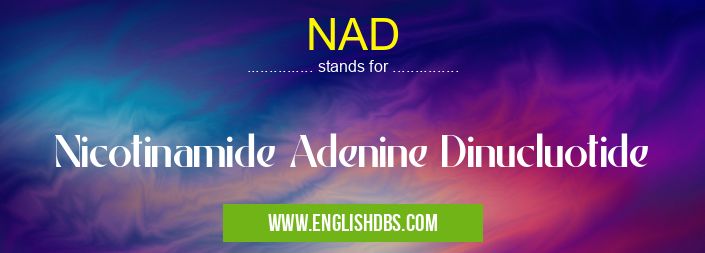What does NAD mean in UNCLASSIFIED
NAD stands for Nicotinamide Adenine Dinucleotide. It is a coenzyme found in all living cells and plays a crucial role in cellular metabolism. NAD is involved in various biological processes, including energy production, redox reactions, and DNA repair.

NAD meaning in Unclassified in Miscellaneous
NAD mostly used in an acronym Unclassified in Category Miscellaneous that means Nicotinamide Adenine Dinucluotide
Shorthand: NAD,
Full Form: Nicotinamide Adenine Dinucluotide
For more information of "Nicotinamide Adenine Dinucluotide", see the section below.
Meaning of NAD
NAD is an abbreviation for the full chemical name Nicotinamide Adenine Dinucleotide. It is a nucleotide composed of two nucleotides: nicotinamide and adenine. The nicotinamide portion of NAD is derived from vitamin B3 (niacin), and the adenine portion is derived from adenosine.
Functions of NAD
- Energy Production: NAD is involved in the electron transport chain, which produces energy in the form of ATP. It acts as an electron carrier, transferring electrons from NADH to the electron transport chain.
- Redox Reactions: NAD is involved in redox reactions, which are chemical reactions involving the transfer of electrons. It acts as an oxidizing agent (NAD+) or a reducing agent (NADH), depending on the reaction.
- DNA Repair: NAD is a precursor to nicotinamide phosphoribosyltransferase (NAMPT), an enzyme involved in the synthesis of NAD+. NAD+ is essential for DNA repair mechanisms, such as base excision repair and nucleotide excision repair.
Essential Questions and Answers on Nicotinamide Adenine Dinucluotide in "MISCELLANEOUS»UNFILED"
What is NAD?
NAD is a coenzyme involved in energy production and numerous cellular processes. It is crucial for mitochondrial function, gene expression, and DNA repair.
What is NAD+ and NADH?
NAD+ (oxidized form) and NADH (reduced form) are the two interconvertible forms of NAD. NADH is generated in energy-producing reactions, while NAD+ is used in energy-consuming processes.
Why is NAD important?
NAD is essential for:
- Energy production through oxidative phosphorylation
- Regulation of cellular metabolism
- DNA repair and cell survival
- Gene expression and aging processes
Is NAD a vitamin?
No, NAD is not a vitamin. It can be synthesized in the body from the amino acid tryptophan and the vitamin niacin (B3).
Can NAD levels decline?
Yes, NAD levels decline with age and in certain diseases. Factors such as stress, inflammation, and calorie restriction can also affect NAD levels.
What are the benefits of increasing NAD levels?
Increasing NAD levels has been linked to:
- Improved mitochondrial function
- Enhanced energy production
- Reduced inflammation
- Improved cognitive function
- Protection against neurodegenerative diseases
How can I increase NAD levels?
You can increase NAD levels by:
- Consuming NAD precursors such as niacinamide
- Taking supplements that boost NAD synthesis
- Exercising regularly
- Restricting calories
- Reducing stress and inflammation
Are there any risks associated with increasing NAD levels?
Excessive NAD levels may have negative effects, such as:
- Flushing
- Itching
- Nausea
- Vomiting
Is NAD the same as NMN?
No, NAD and NMN (nicotinamide mononucleotide) are different molecules. NMN is a precursor to NAD and can be converted to NAD in the body.
Final Words: NAD is a vital coenzyme involved in numerous cellular processes. Its role in energy production, redox reactions, and DNA repair makes it indispensable for cellular metabolism and overall health. Understanding the meaning and functions of NAD is essential for comprehending various biological processes and their implications in living organisms.
NAD also stands for: |
|
| All stands for NAD |
